More than two decades ago, I had the honour of running the world’s last (possibly only) frog telephone helpline. No, this is not a set-up for a punchline. It was a real service. Gardeners would grab the Yellow Pages, dial the frog helpline number and physically manifest, using their voice, sentences most of us would type into Google today: “If I dig a pond, will frogs come?” callers would ask, or: “How can I make my garden more attractive to amphibians?”
My role was simple. I was to fire these callers into action, offering realistic guidance on how gardens could be made more suitable for wildlife, especially frogs. Froglife, the charity that owned the helpline, saw in gardens a way for more amphibian habitats to be secured, away from the countryside which was then (and is still) being ravaged by pollution, land-use changes and more. And so, paid a minimum-wage salary, I spoke to 9,000 callers over a period of about three years.
It was perhaps the best job I ever had. In my spare time, I turned our small concrete backyard into a nature oasis, with two ponds for amphibians. In the years that followed, barely a day would go by when I wouldn’t see a frog stirring or hear the distinctive “plop” of one diving for cover as I walked past the pond. Some years, we had 15 frogs at a time; in spring, the bigger pond became a theatre for raucous, slimy sex. It was like a seasonal soap opera.
Until it wasn’t. Because, as of 2024, all the frogs are gone and no frog helpline can save me from despair. As far as I can tell, the cause of this mass-mortality event was twofold: first, many frogs locally were hit by the heatwave of 2022, which saw temperatures soar to 40C; then came Storm Noa in April 2023, which washed countless blobs of neighbourhood spawn, pairs of frogs still coupling, downstream in a deluge of broiling turbidity. The frogs are gone. And so, naturally, I find myself in a reflective mood. Bluntly, I wonder, was it all worth it? Did my little wildlife garden ever really help, in the long term, frogs and other local wildlife? Were my efforts futile?
First, the good news. Data about the impact the wildlife gardening movement has had on species is limited, but there are many sources that suggest it has been broadly positive. “In the 1970s, garden birdfeeders were dominated by only two species – house sparrow and starling,” says Mike Toms of the British Trust for Ornithology (BTO). “Today, a much broader range of species is commonly seen taking advantage of the growing variety of supplementary foods on offer – particularly for goldfinch and wood pigeon.” According to BTO data, feeding opportunities in many British gardens have enabled one species of migratory bird, the blackcap, to evolve new migration routes that divert through our gardens as if they were calorie-rich service stations, which in a way, they are.
Wildlife gardening efforts in the past few decades are likely to have been important to amphibians, too. “There are around half a million ponds in the British countryside and a range of sources suggest that UK gardeners have created a further 2 to 3 million garden ponds,” says Jeremy Biggs of Freshwater Habitats Trust, a charity seeking to reverse wildlife declines in rivers, lakes and ponds. “Between 5% and 10% of these ponds support nationally threatened species, including great crested newts and common toads, which can’t be a bad thing.”

“We are certainly seeing greater species diversity in the urban environment than the rural,” says Paul Hetherington of the charity Buglife. “That is likely to be down to the wildlife gardening movement, which is having a positive impact.”
Butterflies (a showy insect people can easily monitor) provide important data showing that wildlife gardening matters to insects and other invertebrates. According to research published in April by the charity Butterfly Conservation, letting part of gardens grow wild, allowing for long grasses especially, sees butterfly numbers increase by 18% in urban areas and up to 93% in arable parts of the UK. And so gardens, for some insects, are likely to be a lifeline in some parts of Britain.
Each year is different, of course. As others have reported, 2024 seems so far to be a poor year for bats, wasps and some wildflower species. Even Jeremy Clarkson, usually loudly ambivalent on issues of climate, has stated (without any hint of irony) that he is “a bit alarmed” at how few butterflies there appear to be this year.
Will urban and suburban wildlife adapt to an era of changing climate and more extreme weather? In some cases, it’s already happening. In the UK, for instance, butterflies and moths have been found to emerge (on average) one to six days earlier, for each decade that passes. Many aphid species now hatch a month earlier than they did half a century ago. In the UK, between 1971 and 1995, 63% of bird species nested earlier, by an average of nine days. So, yes – animals are evolving. The question is: will they adapt quickly enough to deal with the challenges we are throwing their way? Are my frogs, a single passing meta-population, the mucus-covered harbingers of worse to come? The single cut in the death by a thousand?
According to Kate Bradbury, author of the recent wildlife gardening memoir One Garden Against the World, my worries about amphibians have seen me fall into (what she calls) an “eco-anxiety sinkhole” that isn’t helpful to anyone. “I pretty much tell people who are despairing to hold on in there, to keep going, and to focus on what is here over what isn’t, which I try to do myself,” she says. “But yes, it can be pretty miserable.”
To help garden wildlife in these topsy-turvy seasons, Bradbury has resorted to leaving piles of worms for robins, planting crocuses for queen bumblebees needing shelter next spring and hand-rearing caterpillars. She has recently installed a metre-deep trench that stays damp in punishingly hot summers, day and night, which she calls her “climate change bunker” for frogs. It even has a little ladder. She sounds like a battlefield medic, I tell her, entering her warzone each day, tending to the desperate needs of her animal residents. “Well, yeah. It’s an emergency,” she responds. “But what’s the alternative – letting it all slip away without trying?”
after newsletter promotion

Chris Baines’s 1985 classic book, How to Make a Wildlife Garden (which influenced many gardeners, including Monty Don and Alan Titchmarsh), never spoke with such urgency. Wildlife gardening all seemed rather quaint, back then. There was a general assumption (you see it in all of the glossy two-page spreads of old wildlife gardening books) that 100% of readers had at their disposal exactly the same long, lush, semi-detached suburban garden, with hedgehogs and great spotted woodpeckers queuing up around the edges, eager to come and explore. There was barely a mention of the climate catastrophe and certainly no mention of plastic grass – a wildlife-demeaning blight thought to exist in as many as one in 10 of the UK’s 30m gardens today. Nor were there pleas that people refrain from paving over their front gardens – a trend, partly to make space for vehicles, that has seen 4.5m potential sites for wildlife lost in recent years.
Grass, or rather the length of grass, has become another contentious issue in wildlife gardening lore. Monty Don, for instance, used to be a strong advocate for leaving patches of long, messy grass for wildlife, but confessed only last week to having a love of the manicured lawn all along. (“The lawn is back, Monty Don decrees”, the Telegraph declared). Alan Titchmarsh, considered gardening royalty by some, has also frustrated wildlife campaigners in recent years. In a 2023 House of Lords inquiry he said of the movement: “a rewilded garden will offer nothing but straw and hay from August to March,” and that this “fashionable and ill-considered trend” may go on to “deplete our gardens of their botanical riches”. Is it time for these established voices to commit more fully to the long grass? Perhaps.
So what is the best wildlife gardening advice in 2024? Wildlife charities have plenty of suggestions. Now that some insects no longer hibernate through the winter, for instance, Buglife is keen to see wildlife gardening become more of a year-round activity, where carefully chosen nectar-producing plants are available in every season to suit the appetite of the species most in need. Mike Toms of the BTO thinks messaging about diseases is important in wildlife gardening literature, pointing to recent declines in greenfinches and chaffinches linked to diseases transmitted, in part, via garden birdfeeders. Butterfly Conservation wants to encourage those without large, manicured gardens to do their bit: those with a balcony or a small patio can still help wildlife through pots filled with the nectar-rich flowers and food plants (such as nasturtiums) that butterflies can use to complete their lifecycle.
Advice about garden ponds could also do with an update: “Small ponds can be more vulnerable to heating and drying than larger sites, so we might advise ensuring that ponds in gardens are a bit more shaded to mitigate the impact of hot weather,” suggests Jeremy Biggs of the Freshwater Habitats Trust. “The most important message nowadays for anyone with a pond is that freshwater wildlife needs clean, unpolluted water. More facilities to store rainwater, such as water butts, would help.”
“Gardening is unlikely to stop climate change,” says Kate Bradbury, “but backyard nature can connect us with the natural world, making us more aware of the destruction all around us – tuning us into the life systems that support us. I see that as a good thing.”
The youthful, wet-behind-the-ears helpline operator in me stirs. I start to feel slightly more optimistic. With any luck, new frogs will find their way to my patch one of these days. But if they don’t, there’s still plenty to occupy my time. My community is about more than just this one amphibian, I am learning. I poke my head out of my eco-anxiety hole; I step out of the bunker.

Comments (…)
Sign in or create your Guardian account to join the discussion